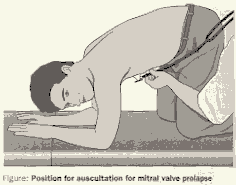Auscultation for mitral valve prolapse
SIR-Mitral valve prolapse syndrome is common in young adults, particularly in teenage girls and non-whites. In symptomatic pationts with chest pain and multiple vague complaints one has to make a correct diagnosis when the resting electrocardiogram shows nonspecific changes. The diagnosis can be confirmed by echocardiography, but this may be prohibitively expensive ~ poorer countries. More than half of patients do not have the usual tell-tale systolic click and late systolic murmur on clinical examination. The presence of this click-murmur sign makes the diagnosis not only easy but very inexpensive. In patients suspected of having mitral valve prolapse syndrome, if conventional auscultation does not bring out the click-murmur sign, they should be put in the knee-elbow position (figure) which
 most of these patients will be able to do easily since they are young and do not have significant disability. When the patient has assumed this position comfortably, the mitral area should be auscultated with the diaphragm of the stethoscope. The click-murmur sign can then be clearly brought out giving the diagnosis. The diagnosis was confirmed in 10() consecutive patients in whom echocardiography was also done.
most of these patients will be able to do easily since they are young and do not have significant disability. When the patient has assumed this position comfortably, the mitral area should be auscultated with the diaphragm of the stethoscope. The click-murmur sign can then be clearly brought out giving the diagnosis. The diagnosis was confirmed in 10() consecutive patients in whom echocardiography was also done.
B M Hegde
Kasturba Medical College, Mangalore 575001,